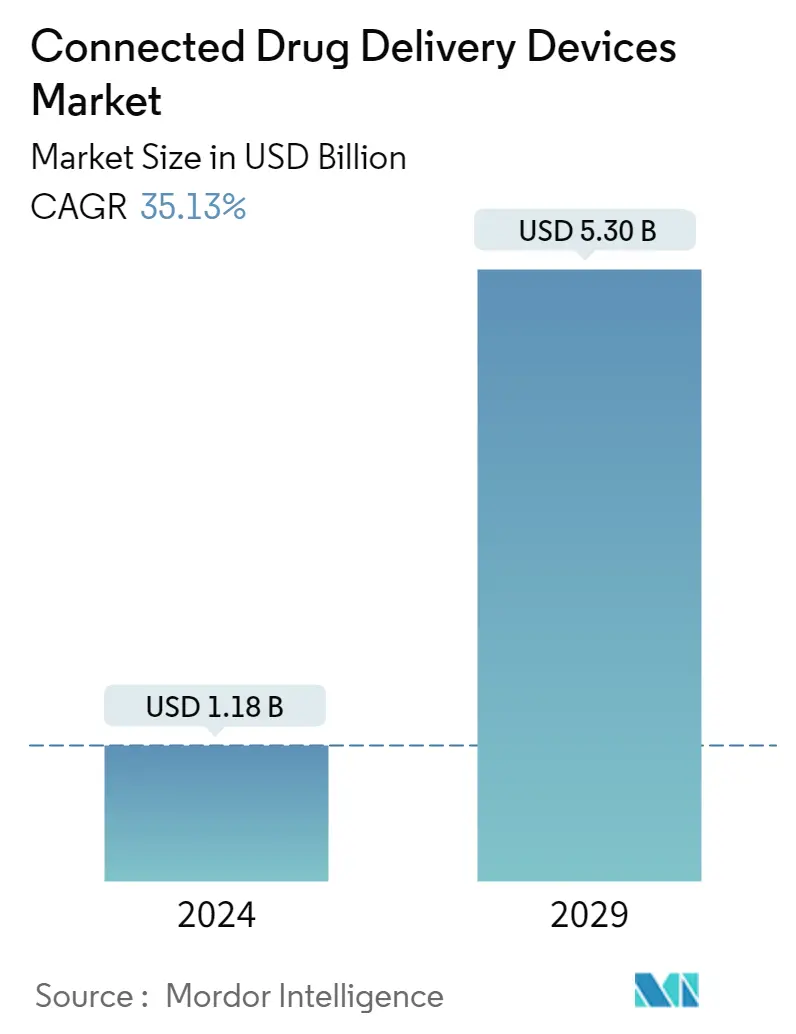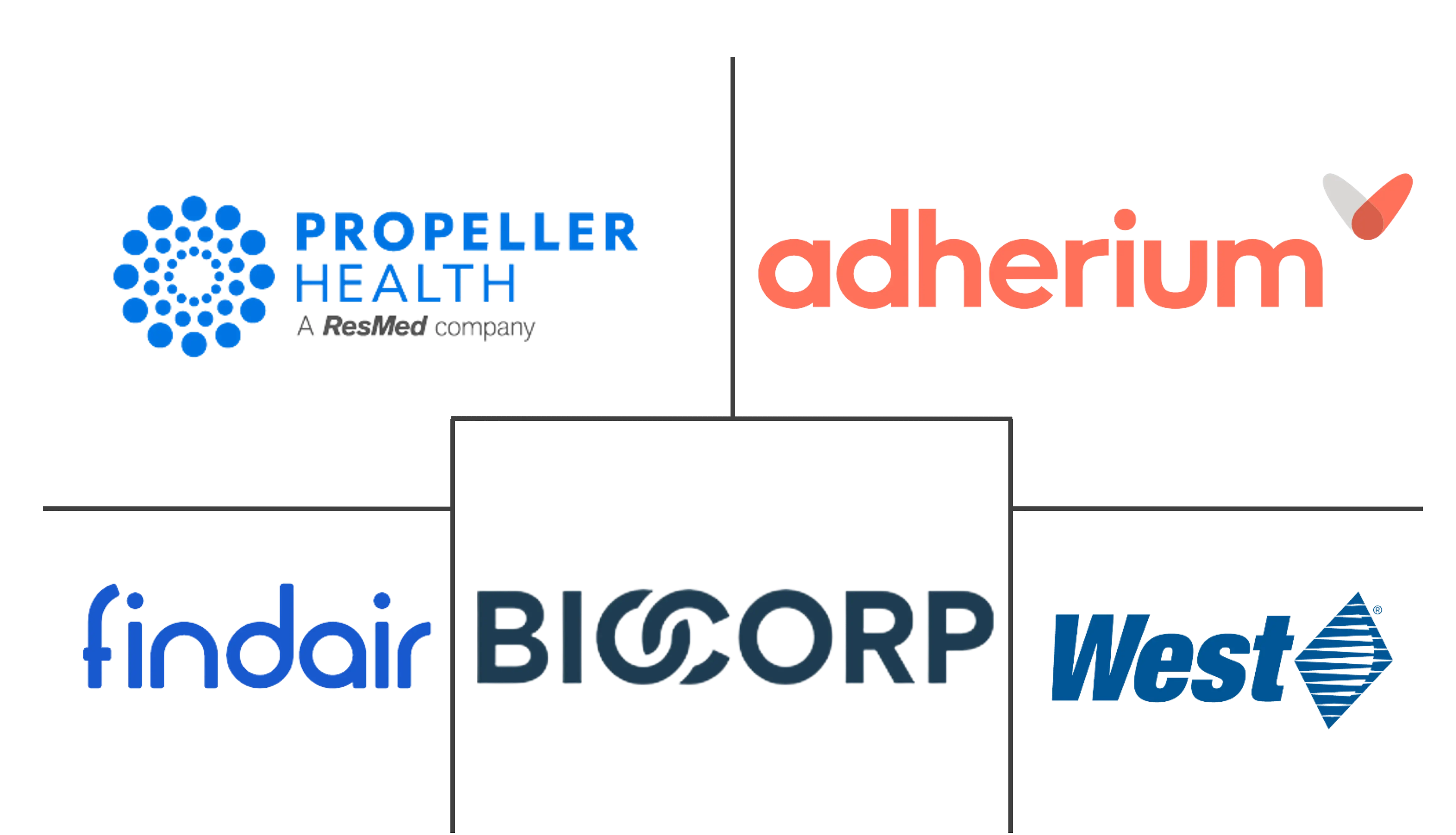Market Size of Connected Drug Delivery Devices Industry

| Study Period | 2019 - 2029 |
| Market Size (2024) | USD 1.18 Billion |
| Market Size (2029) | USD 5.30 Billion |
| CAGR (2024 - 2029) | 35.13 % |
| Fastest Growing Market | Asia Pacific |
| Largest Market | North America |
| Market Concentration | Medium |
Major Players
*Disclaimer: Major Players sorted in no particular order |
Connected Drug Delivery Devices Market Analysis
The Connected Drug Delivery Devices Market size is estimated at USD 1.18 billion in 2024, and is expected to reach USD 5.30 billion by 2029, growing at a CAGR of 35.13% during the forecast period (2024-2029).
The COVID-19 pandemic impacted the market moderately during the initial phase as patient care shifted to more home-based technologies, and along with it the usage of connected drug delivery also expectedly increased. For instance, according to an article published by the Lancet Regional Health in September 2021, it has been observed that since the beginning of the COVID-19 pandemic, home-based care has been unprecedently solicited to relieve the pressure on hospitals, enabling patients with chronic conditions to be taken care of and monitored at home. This indicates the increased usage of connected drug delivery devices during the pandemic, as they are specially made for remotely monitoring a patient. Thus, the COVID-19 pandemic significantly impacted the market initially, however as the pandemic has subsided currently, the shift of patient care in home settings has decreased a bit, but the market studied is expected to have stable growth during the forecast period of the study.
The major factors driving the growth of the market include the increasing prevalence of chronic diseases, such as asthma, COPD, and diabetes, increased patient connectivity and engagement, and rising patient awareness about adherence to prescribed therapies.
The increasing prevalence of chronic diseases such as asthma, chronic obstructive pulmonary disease (COPD), and diabetes among others coupled with the rising geriatric population is expected to boost the market growth, as the connected drug delivery devices are mainly used by patients suffering from the aforementioned diseases. For instance, according to the data published by Global Initiative for Chronic Obstructive Lung Disease in September 2022, it was estimated that 200 million people around the world had COPD in 2022. Similarly, according to an article published by Lung India in December 2021, a systematic review was conducted in India which showed that the pooled COPD prevalence in adults was 9.23% in 2021. Thus, the high burden of COPD is expected to boost market growth.
The rising prevalence of diabetes around the world is also a major factor driving the market growth, as blood ketone meters are used for diabetes monitoring. For instance, according to the data updated by IDF in December 2021, it was estimated that approximately 537 million adults in the age group of 20-79 years were living with diabetes in 2021, and the total number of people living with diabetes is projected to rise to 643 million by 2030 and 783 million by 2045.
Moreover, according to an article published by the Journal of Asthma Allergy in July 2022, asthma is one of Germany's most common chronic diseases, which affects an estimated 4-5% of all adults and 10% of children each year. Additionally, according to an article published by BMC Public Health in July 2022, a study was conducted in China which showed that the estimated prevalence, awareness, and control rates of diabetes in Chinese individuals aged over 65 years were 18.80%, 77.14%, and 41.33%, respectively. Hence, the high prevalence of asthma and diabetes is also expected to boost the usage of connected drug-delivery devices, thus enhancing market growth.
Hence, the aforementioned factors such as the rising prevalence of chronic diseases such as asthma, COPD, and diabetes coupled with the rising geriatric population are expected to boost the market growth. However, the increased cost of devices and the increasing concerns about data privacy and transfer are expected to impede market growth.
Connected Drug Delivery Devices Industry Segmentation
As per the scope of the report, connected drug delivery devices are wireless connected and smart electronic devices that allow patient-administrated therapy. These drug delivery devices are packed with electronics and sensors that allow for tracking dose delivery & timing and offer instant feedback to patients. The Connected Drug Delivery Devices Market is Segmented By Product (Connected Sensors and Integrated Connected Devices), Technology (Bluetooth, NFC, and Other Technologies), End User (Healthcare Providers and Homecare), and Geography (North America, Europe, Asia-Pacific, Middle East & Africa, and South America). The market report also covers the estimated market sizes and trends for 17 countries across major global regions. The report offers the value (USD million) for the above segments.
| By Product | ||||
| ||||
|
| By Technology | |
| Bluetooth | |
| Near-field communication (NFC) | |
| Other Technologies |
| By End User | |
| Healthcare Providers | |
| Homecare |
| By Geography | ||||||||
| ||||||||
| ||||||||
| ||||||||
| ||||||||
|
Connected Drug Delivery Devices Market Size Summary
The connected drug delivery devices market is poised for substantial growth, driven by the increasing prevalence of chronic diseases such as asthma, COPD, and diabetes, alongside a rising geriatric population. These devices, which facilitate remote patient monitoring and adherence to prescribed therapies, gained traction during the COVID-19 pandemic as patient care shifted towards home-based solutions. Although the initial impact of the pandemic has subsided, the demand for these devices remains robust due to the ongoing need for managing chronic conditions. The market is characterized by its fragmented nature, with key players engaging in strategic collaborations and product innovations to maintain competitive advantage.
North America is expected to be a significant market due to the high incidence of chronic diseases and a substantial target population. The region's growth is further supported by the increasing geriatric population, which is more susceptible to such conditions. The market's expansion is also fueled by technological advancements and the introduction of connected devices that enhance patient engagement and connectivity. Despite challenges such as high device costs and data privacy concerns, the market is anticipated to experience steady growth, with home care settings emerging as a key segment due to the rising cases of cardiovascular diseases and other chronic ailments.
Connected Drug Delivery Devices Market Size - Table of Contents
-
1. MARKET DYNAMICS
-
1.1 Market Overview
-
1.2 Market Drivers
-
1.2.1 Increasing Prevalence of Chronic Diseases Such as Asthma, COPD, and Diabetes
-
1.2.2 Increased Patient Connectivity and Engagement
-
1.2.3 Rising Patient Awareness About Adherence to Prescribed Therapies
-
-
1.3 Market Restraints
-
1.3.1 Increased Cost Of Devices
-
1.3.2 Increasing Concerns About Data Privacy And Transfer
-
-
1.4 Industry Attractiveness - Porter's Five Forces Analysis
-
1.4.1 Bargaining Power of Suppliers
-
1.4.2 Bargaining Power of Buyers/Consumers
-
1.4.3 Bargaining Power of Suppliers
-
1.4.4 Threat of Substitute Products and Services
-
1.4.5 Intensity of Competitive Rivalry
-
-
-
2. MARKET SEGMENTATION (Market Size by Value - USD million)
-
2.1 By Product
-
2.1.1 Connected Sensors
-
2.1.1.1 Connected Inhaler Sensors
-
2.1.1.2 Connectable Injection Sensors
-
-
2.1.2 Integrated Connected Devices
-
2.1.2.1 Connected Inhaler Devices
-
2.1.2.2 Connected Injection Devices
-
-
-
2.2 By Technology
-
2.2.1 Bluetooth
-
2.2.2 Near-field communication (NFC)
-
2.2.3 Other Technologies
-
-
2.3 By End User
-
2.3.1 Healthcare Providers
-
2.3.2 Homecare
-
-
2.4 By Geography
-
2.4.1 North America
-
2.4.1.1 United States
-
2.4.1.2 Canada
-
2.4.1.3 Mexico
-
-
2.4.2 Europe
-
2.4.2.1 United Kingdom
-
2.4.2.2 Germany
-
2.4.2.3 France
-
2.4.2.4 Italy
-
2.4.2.5 Spain
-
2.4.2.6 Rest of Europe
-
-
2.4.3 Asia-Pacific
-
2.4.3.1 China
-
2.4.3.2 Japan
-
2.4.3.3 India
-
2.4.3.4 Australia
-
2.4.3.5 South Korea
-
2.4.3.6 Rest of Asia-Pacific
-
-
2.4.4 Middle East & Africa
-
2.4.4.1 GCC
-
2.4.4.2 South Africa
-
2.4.4.3 Rest of Middle East & Africa
-
-
2.4.5 South America
-
2.4.5.1 Brazil
-
2.4.5.2 Argentina
-
2.4.5.3 Rest of South America
-
-
-
Connected Drug Delivery Devices Market Size FAQs
How big is the Connected Drug Delivery Devices Market?
The Connected Drug Delivery Devices Market size is expected to reach USD 1.18 billion in 2024 and grow at a CAGR of 35.13% to reach USD 5.30 billion by 2029.
What is the current Connected Drug Delivery Devices Market size?
In 2024, the Connected Drug Delivery Devices Market size is expected to reach USD 1.18 billion.

